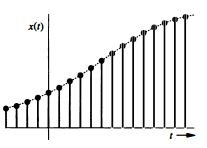Discrete-time signals play a vital role in modern signal processing, offering specific values at distinct points in time. Unlike analog signals, which provide continuous value information at any given moment, discrete time signals sample data at fixed intervals. This article explores the fundamentals of discrete time signals, their relationship to analog signals, and the key concepts of sampling, time intervals, and amplitude. Through visual examples, we’ll understand how discrete signals differ from analog and why they are essential in various digital applications.
What is Discrete-Time Signal?
A signal that is obtained at specific intervals of time, meaning that a signal with certain specific values obtained at certain specific times is called a discrete time signal.


In an analog signal, we can get the value of the signal continuously at any moment. But in a discrete time signal, we do not get the value of the signal at every moment.
In Figure 2, the analog signal is divided into small parts. This division of the signal into smaller parts is called sampling.
The signal is divided into 10 parts within the 0 to 100 seconds range. Hence, each segment has a value of 10. We can get a specific value of the signal at intervals of 10 seconds. Similarly, we can get specific values of the signal at 20, 30, 40… up to 100 seconds. However, we do not know any specific value of the signal between 1 and 9 seconds, or between 11 and 19 seconds, or between 21 and 29 seconds.
Again, from Figure 1: From 0 to 10 seconds, or from 10 to 20 seconds… up to 100 seconds, we can get the specific value of the signal continuously at every moment, which we cannot get from Figure 2. From Figure 2, we get the specific value of the signal at discrete intervals.
Therefore, it can be said:
- A discrete time signal provides specific values at specific times.
- In a discrete time signal, time is discrete, but amplitude remains the same (constant). For example, in Figures 1 and 2, the amplitude values at 10 or 20 seconds in both the Analog Signal and the Discrete Time Signal remain the same.
- Every discrete time signal is a subset of an analog signal. This is because adding all the points of the physical quantity of a discrete time signal would give us the analog signal (Figure 3).

1. What is an example of a discrete-time signal?
A discrete-time signal could be a sequence of temperature readings taken at regular intervals throughout the day or the number of website visitors recorded every hour.
2. What is a continuous-time signal?
A continuous-time signal is one where the signal’s value is defined for every possible moment in time. For instance, an analog audio signal is continuous because it captures every detail of sound variations over time.
3. What is the formula for a discrete-time signal?
A discrete-time signal is often represented as x[n]x[n]x[n], where nnn is an integer, indicating the discrete time index, and xxx is the signal value at that specific time index.
4. What is the difference between a discrete-time signal and a continuous-time signal?
The key difference lies in the time domain. A discrete-time signal is defined only at specific intervals, while a continuous-time signal has values at all points in time. Discrete signals are typically used in digital systems, while continuous signals are common in analog systems.
5. What are some common problems and solutions for discrete-time signals?
Problems with discrete-time signals may include aliasing due to insufficient sampling rates or quantization errors. Solutions include using a higher sampling rate to avoid aliasing or employing anti-aliasing filters before sampling.
6. What are the properties of a discrete-time signal?
Periodicity: The signal repeats after a specific number of samples.
Linearity: The signal follows linearity when scaled or summed.
Time-invariance: The signal remains unchanged if the time index is shifted.
Causality: A signal is causal if it depends only on present and past values, not future ones.
7. What is a digital signal?
Key properties of discrete-time signals include:
A digital signal is a representation of a physical signal in discrete-time form, where the signal takes on distinct quantized values. Digital signals are used in computing and digital communication systems.
8. What is an analog signal?
An analog signal is a continuous signal that represents physical quantities, varying smoothly over time. It is commonly used in systems like audio, radio, and video broadcasting.



